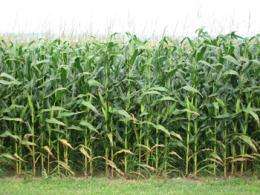Study targets disease resistance in corn

(PhysOrg.com) -- In a paper published online this week in Nature Genetics, North Carolina State University and U.S. Department of Agriculture crop scientists and plant pathologists sift through millions of genetic sequence variations in the set of all genes in maize (corn) to identify 51 gene regions associated with resistance to Southern corn leaf blight disease – an important plant pathogen.
Finding out more about the mechanisms behind complex traits like disease resistance has the potential to help plant breeders build the best traits into tomorrow’s corn plants, including resistance to some diseases, says Dr. Jim Holland, NC State professor of crop science, research geneticist for the U.S. Department of Agriculture-Agriculture Research Service (USDA-ARS) and the corresponding author of the paper.
Holland and study co-authors Dr. Peter Balint-Kurti, a USDA-ARS research plant pathologist and geneticist who works in NC State’s plant pathology department, and Kristen Kump, an NC State graduate student, joined researchers from Cornell University, the University of Delaware and the University of Missouri to examine a set of 5,000 maize varieties called the maize nested association mapping population. Using this population allowed the researchers to zero in on the parts of the genome responsible for conferring resistance.
The researchers likened the search for Southern corn leaf blight resistance gene regions in maize to looking for specific houses in a large city – without knowing the addresses.
“Using this nested association mapping population, when we find associations with Southern corn leaf blight disease, we know we’re on the right street and maybe have the right house,” Holland says. “If we know which genes control disease resistance, we can make better predictions about which maize varieties will be resistant to disease and focus on breeding those lines.”
Holland and Balint-Kurti hope to build upon these results to learn more about how genes confer disease resistance to Southern corn leaf blight and whether they may also provide resistance to other similar types of diseases in corn and other plant species.
Southern corn leaf blight is a moderate problem in the southeastern United States, Balint-Kurti says, and can be a significant problem in Southeast Asia, southern Europe and parts of Africa. Prevalent in hot, humid climates across the globe, it causes small brown spots on leaves. The spots get larger and eventually spread to the whole plant. Severe infections can cause major corn yield losses.
Balint-Kurti says the study provides “an unparalleled description of the genetic architecture of disease resistance.
“Southern corn leaf blight is a model system for pathologists to study. This research provides the most detailed description of the genetic basis of plant disease resistance of which we are aware,” he added.
In a companion paper in Nature Genetics, Holland and his Cornell colleagues found candidate maize genes related to leaf angle, an important trait that has allowed growers to plant corn crops closer together, resulting in drastically increased corn yields. That study also utilized the maize nested association mapping population.
More information: “Genomewide Association Study of Quantitative Resistance to Southern Leaf Blight in the Maize Nested Association Mapping Population” Kristen Kump, et al. Nature Genetics. Published: Jan. 9, 2011.
Provided by North Carolina State University


















